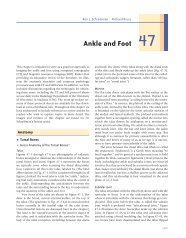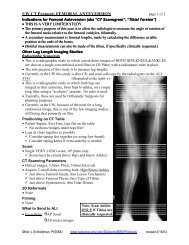CT Protocols: (Brain, ENT, Spine, Vascular) - Department of Radiology
CT Protocols: (Brain, ENT, Spine, Vascular) - Department of Radiology
CT Protocols: (Brain, ENT, Spine, Vascular) - Department of Radiology
Create successful ePaper yourself
Turn your PDF publications into a flip-book with our unique Google optimized e-Paper software.
37 Revised 7/22/09 (Gentry/Ranallo)<br />
Maxill<strong>of</strong>acial Trauma: (Routine)<br />
(Protocol – Adult: # 2.5a – Pediatric: # 12.9 & 12.10)<br />
Billing:<br />
Setup:<br />
1. <strong>CT</strong> Maxi-face without, or with, or with and without<br />
2. Contrast if used<br />
1. Patient Supine, AP and lateral scouts, no gantry angle<br />
2. Extend the scouts to include aortic arch for smart prep.<br />
3. Remove all metallic and high-density objects from the scanning area.<br />
4. Patient Positioning: Tilt the patient’s head so that a line connecting the lateral<br />
canthus and the EAC is perpendicular to the <strong>CT</strong> tabletop (see head <strong>CT</strong> protocol).<br />
5. Scanning begins just below the genu <strong>of</strong> the mandible to the top <strong>of</strong> the frontal sinuses<br />
Contrast:<br />
Patient Age<br />
1. Routine: w/o contrast. Use the following injection parameters if done w/ contrast.<br />
2. Adults: 100 ml <strong>of</strong> 240 mg/ml nonionic contrast (use 150ml <strong>of</strong> 240mg/ml if a <strong>CT</strong> head<br />
will also be obtained); Pediatrics: 1 ml/lb (2 ml/kg) <strong>of</strong> 240 non-ionic contrast.<br />
3. Injection Rate: Adults: 3.5 ml/sec; Pediatric: 2 ml/sec<br />
4. Smart prep over the aortic arch and begin scanning 15 seconds (adults) or 8<br />
seconds (pediatrics) after arrival <strong>of</strong> contrast in the arch<br />
: Choose the <strong>CT</strong> scan factors on the scanner for the proper age range <strong>of</strong> the patient<br />
1. Child: (3 – 6 years)<br />
2. Infant: (0 – 3 years)<br />
DFOV:<br />
Preferred 17.2 cm (Range 15-18 cm)<br />
Recons & Reformats:<br />
1. All 2-D reformats described below are to be done as 2 mm x 2 mm reformats as shown in<br />
the image below<br />
Oblique Sagittal: Through each orbit parallel to the optic nerves.<br />
Sagittal:<br />
Coronal:<br />
Through both orbits. Be sure to include both TMJs.<br />
From the anterior aspect <strong>of</strong> the superior orbital rim through the<br />
sella. Be sure to include all <strong>of</strong> the TMJ.<br />
2. If this is an exam solely with contrast or solely without contrast: Do 2D-reformats using<br />
both the standard 1.25 mm images (Recon 1) AND the bone images (Recon 2)<br />
3. If this is a “with & without” contrast study: Do not do Recon 2 on the contrast scan. Do<br />
2D-reformats using the standard 1.25 mm images (Recon 1) only from the contrast series<br />
AND also do 2mm x 2mm reformats using the bone images (Recon 2) from the noncontrast<br />
series.
















